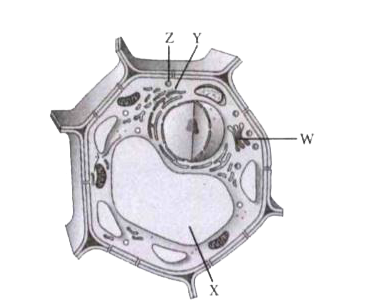Assertion: Members of protists are eukaryotes.
Reason: Protistan cell body does not contain a well defined nucleus and other membrane bounded cell organelles.
If both assertion and Reason are true and the reason is a correct explanation of the assertion.
If both Assertion and Reason are true but Reason is not a correct explanation of the Assertion.
If Assertion is True but the Reason is False.
If both Assertion and Reason are False.
The correct Answer is:C
Step-by-Step Solution:
1. Understanding the Assertion: The assertion states that "Members of protists are eukaryotes." This is true because protists are indeed classified as eukaryotic organisms. Eukaryotes are characterized by having cells with a well-defined nucleus and membrane-bound organelles.
2. Understanding the Reason: The reason provided states, "Protistan cell body does not contain a well-defined nucleus and other membrane-bounded cell organelles." This statement is false. Protists, being eukaryotes, do contain a well-defined nucleus and membrane-bound organelles.
3. Analyzing the Relationship: Since the assertion is true and the reason is false, we need to evaluate the relationship between them. The reason does not correctly explain the assertion because it contradicts the definition of protists as eukaryotes.
4. Conclusion: Based on the analysis, the correct answer is that the assertion is true, but the reason is false.
Final Answer: Assertion is true, but reason is false.
---
Topper's Solved these Questions
- DIVERSITY IN LIVING WORLD (PLANT DIVERSITY)BOOK - ALLENCHAPTER - DIVERSITY IN LIVING WORLD (PLANT DIVERSITY)EXERCISE - EXERCISE -III
136 Videos
- DIGESTION AND ABSORPTIONBOOK - ALLENCHAPTER - DIGESTION AND ABSORPTIONEXERCISE - S
28 Videos
- DOMESTICATION OF PLANT (PLANT BREEDING)BOOK - ALLENCHAPTER - DOMESTICATION OF PLANT (PLANT BREEDING)EXERCISE - S
28 Videos
Similar Questions
The number of and types of organisms present on earth, this refers to as?
View SolutionCrypts of Lieberkuhn are found in
View SolutionGreen revolution means :-
View SolutionAssertion : The cells that have membrane bound organelles are called eukaryotic.
Reason : The cells that lack membrane bound organelles are called prokaryotic.
View SolutionAssertion : Bacteria are prokaryotic. Reason : Bacteria do not posses true nucleus and membrane bound cell organelles.
View SolutionAssertion : The protistan cell body contains a well-defined nucleus and other membrane bound organelles. Reason : Protistans have eukaryotic organisation.
View SolutionAssertion:- Ribosomes are involved in protein synthesis. Reason:- They are membrane bound cell organelles.
View SolutionAssertion : Eukaryotes contain membrane bound cell organelles and linear chromosome present in nucleus.
Reason : In prokaryotes nucleus is present.
View SolutionWhich of the following organisms contain well-defined nucleus and membrane -bound organelles ?
View Solutionअभिकथनः जिन कोशिकाओं में झिल्ली आबद्ध अंगक होते हैं, उन्हें यूकेरियोटिक कहा जाता है।
तर्क: जिन कोशिकाओं में झिल्ली आबद्ध अंगक नहीं होते हैं, उन्हें प्रोकेरियोटिक कहते हैं।
View SolutionAssertion : The cells that have membrane bound organelles are called eukaryotic.
Reason : The cells that lack membrane bound organelles are called prokaryotic.
View Solutionकथन :- प्रोटिस्टा के सदस्य युकेरियोट्स होते है।
कारण :- प्रोटिस्टियल कोशिकीय शरीर में सुविकसित केन्द्रक एवं झिल्लीयुक्त कोशिकांग नहीं होते है।
View SolutionAssertion : The protistan cell body contains a well-defined nucleus and other membrane bound organelles.
Reason : Protistans have eukaryotic organisation.
View SolutionAssertion: In eukaryotic cells, there is an extensive compartmentalisation of cytoplasm is seen
Reason: Eukaryotic cells have membrane bound organelles.
View SolutionAssertion : Eukaryotes contain membrane bound cell organelles and linear chromosome present in nucleus.
Reason : In prokaryotes nucleus is present.
View SolutionAn eukaryotic cell possesses true nucleus bounded by nuclear membrane. Other membrane bound organelles are also present in an eukaryotic cell.

identify W,X,Y and Z
View Solution
